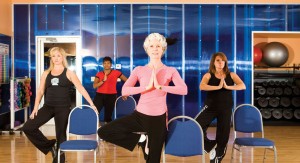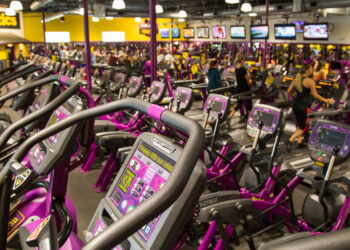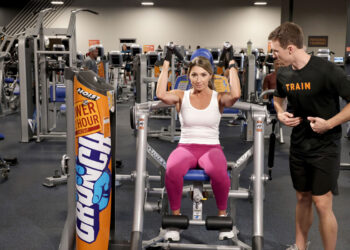
Americans are AWAKENING to the concept of preventive health care to improve quality of life and stave off potentially life threatening illnesses. In no segment is this truer than people aged 55 and older.
Federal Reserve and market research reports state that the 50-plus market owns about 70 percent of the nation’s wealth and is two to three times more likely to spend that wealth on fitness, health and wellness products and related services. Is your club doing all it can to keep your wealthiest and, perhaps, most motivated members happy?
Follow the money
Older members often have more money to spend, keep their memberships longer, interact with your profit centers more and are typically more likely to refer their friends and family than younger members. “Today’s seniors tend to have spending power and are educated, active and sharp consumers,” said Wendy Jett, corporate group fitness director for Urban Active Fitness. Part of why this is true is that seniors stand more to gain from sticking to a fitness regimen — it may be the one thing allowing them to live independently, making their interest great.
“Just looking at the numbers you’d have to be insane not to look at this market,” said Colin Milner, president and CEO of the International Council on Active Aging (ICAA), an education and information resource for professionals in the retirement, assisted living, fitness, rehabilitation and wellness fields.
When Lifestyle Family Fitness in Countryside, Fla., first offered SilverSneakers, a fitness program for people 65 and older that is covered under many health plans, more than 300 members signed up in the first week alone, said Patty Vinson, Florida district instruction coordinator for SilverSneakers. Members were eager to take part in exercises that emphasized an improved quality of life. “Sometimes the driving force for them is just knowing they need to be more fit and take care of their bodies,” added Vinson.
Another benefit of reaching out to older members is that it will increase traffic at your club in the typically slow late morning and early afternoon hours, said Brandon Flowers with California-based training company The Dynamic Advantage. “This can translate into more opportunities to sell your personalized programs and generate significantly more (non-dues) revenue.”
Different Needs
Joining a health club may be outside a senior’s comfort zone, said Nancy Judevine, Active Older Adult and Youth Fitness program supervisor for Provena Saint Joseph Inwood Athletic Club in Illinois. Friendly front desk workers create a positive experience for seniors that will welcome them to your club and keep them there, according to Sheila Gardner, fitness director for Gainesville Health and Fitness Center(GHFC). “Stellar customer service cannot be emphasized enough,” she added. “Staff must be able to spend extra time with these members.”
The same is true for your training staff, said Janie Clark, president of the American Senior Fitness Association. They should be well-educated to the needs of older clients and able to work closely with them, no matter what their fitness levels may be. “The most important step a club can take to increase senior membership is to employ a staff (that is) well-educated on senior-specific health and fitness issues,” said Clark.
The layout and design of your club can be modified to invite more participation from older members. About 66 percent of Americans over 80 have problems stooping, kneeling or crouching, Milner suggested, but many fitness club stretching areas expect members to use the floor. Other clubs may have equipment on a second story that requires people with compromised knees and hips to climb many stairs.
In terms of space and equipment, your club may already have what members need to create an effective, low-impact workout. Elastic resistance bands are light and can be used by people of many different fitness levels for strength training and in group classes. Sturdy chairs, light hand weights and balls are also appropriate for older members, said Jett.
Adding strength and cardio options on the first-level workout floor serves people who cannot take the stairs. Reaching out to older members is all about modifying, Vinson suggested. With some extra instructor training, a yoga class can be done from the comfort and stability of a chair, and Pilates can be moved into the pool — not only catering to older members but also to those with injuries and physical limitations, as well as pregnant women. “Seniors want to know that you and your club offer programming that is safe,” Flowers added. “They are enthusiastic about exercising; however, they prefer low-risk, high-benefit activities that promote safety first.”
Using pools and aquatics areas to hold modified versions of popular group exercise classes is one way to provide safe exercise options for seniors. Rebecca “Boo” Cardozo-Pfeiffer, JD, MPH, innovator of Poolates and President of Pfeiffer Fitness Inc. says, “Poolates has all the benefits of Pilates, but the aquatic environment is extra beneficial for those who have trouble getting on and off the floor or equipment.” She adds that classes held in a pool allow seniors to strengthen the core, improve posture and balance, and increase flexibility – all of which are very important for enhancing longevity and aiding in injury prevention.
Many seniors can also benefit from access to special aquatics equipment that is made with their specific needs in mind. For example, Sprint Aquatics produces a variety of aquatic therapy items that are designed to support and assist senior members with rehab and recovery from injury, strokes and surgery, as well as general exercise needs. “Our products can help aging members because they are lightweight, easy to use and the results will be consistent with what they are used to,” said Laurel Maas, president and CEO of Sprint Aquatics.
Marketing and Follow Through
To create a marketing message that resonates with older populations, you should focus on functionality. Help them understand that your programs and services can help to increase their flexibility, stability and endurance, and emphasize disease prevention and amelioration, Clark said.
Let the overall focus of your programming be health and wellness rather than fitness for its own sake, Milner said. A 70-year-old person might not be interested in firm thighs and rock hard abs, but may be looking for routines that help him or her stay mobile, lift more and maintain an active and independent lifestyle.
Try to avoid describing or advertising programs, activities and events with labeling words like “seniors” or “elderly,” Judevine said. “Many older adults are young at heart, active and vital and may dislike (such) terms.” According to Gardner, GHFC uses the description of a class to explain for whom it is appropriate, rather than specifying a particular age range.
Another way to attract and keep older members is by providing opportunities for social engagements between members and staff beyond the standard programming. Special get-togethers and mixers can be a great way to encourage members to bring their non-member friends and expand your membership.
Creating off-site demonstrations and free classes for seniors at community centers and living facilities can be another good way to spread the word about what your club has to offer older exercisers and reduce the intimidation factor that may be preventing them from coming to your gym in the first place.
If seniors are satisfied with their club they will be members forever, and they will be instrumental in increasing member retention and member referrals. -CS
Start Building Senior Memberships Today!
Experts say to keep older members happy and your business is sure to grow. Here are some inexpensive ways to attract, engage and keep seniors using your club’s services and profit centers:
Put your best face forward. Older members respond to good customer service, warm, friendly greetings and staff who answer questions, says Patty Vinson with Lifestyle Family Fitness’ Florida-region SilverSneakers program. Train your front desk staff to make a special effort — it will be worth it.
Redefine “core” training. One in three people over age 65 will experience a fall. Focus on strengthening legs and improving balance, as opposed to concentrating on the abs and back muscles, suggests Colin Milner with the International Council on Active Aging.
Function matters. In training or group exercise, select exercises that will make it easier for members to reach tall objects, lift their grandchildren or kneel and stand with more stability. Make the regimen center around functional training, advises Wendy Jett with Urban Active Fitness.
Schedule wisely. Older members tend to avoid crowds. Make senior-friendly classes available in the morning or early afternoons and save the high-impact classes for rush hour.
Drop the labels. Avoid labeling a class as “50-plus” or “for seniors.” Older members don’t want to feel isolated from the rest of the club. Instead, focus on the function of the class and let anyone who may benefit, regardless of age, participate,” says Brandon Flowers with California-based training company The Dynamic Advantage.
Ask members for input. The best way to determine the needs and expectations of your older members is to ask them. You may be surprised at how happy they are to help!
INDUSTRY RESOURCES:
American Senior Fitness Association
www.seniorfitness.net
The Dynamic Advantage
www.dynamicstrength.com
International Council on Active Aging
www.icaa.cc
Poolates
www.poolates.com
Sprint Aquatics
www.sprintaquatics.com









A local healthclub that I attended attempted to incorporate seniors in their club, by having a senior trainer on staff. Unfortunately, this trainer was only available evenings after 5 and often was late for classes. Additionally there are 5 steps to get into the building. Not conducive to making a dainty entrance into the gym area when you have to pull yourself up the stairs.